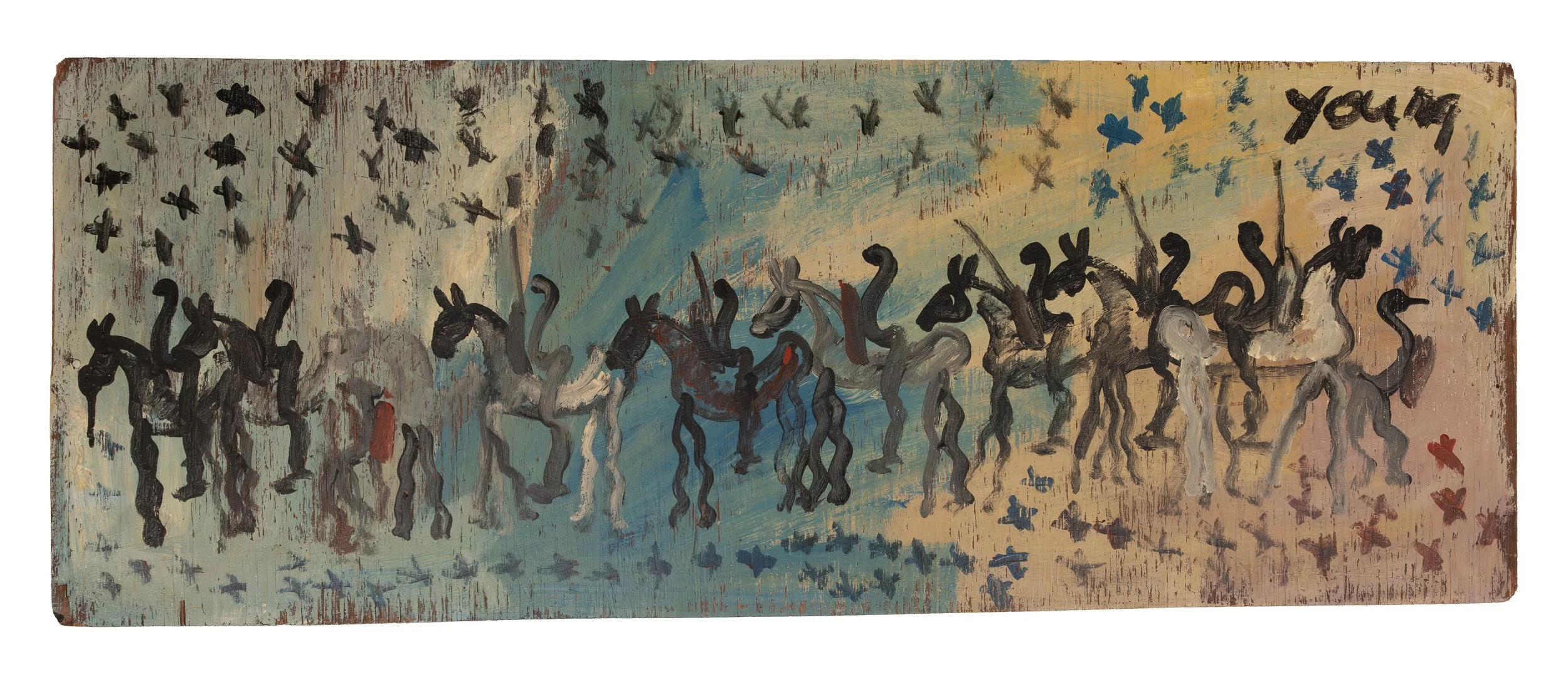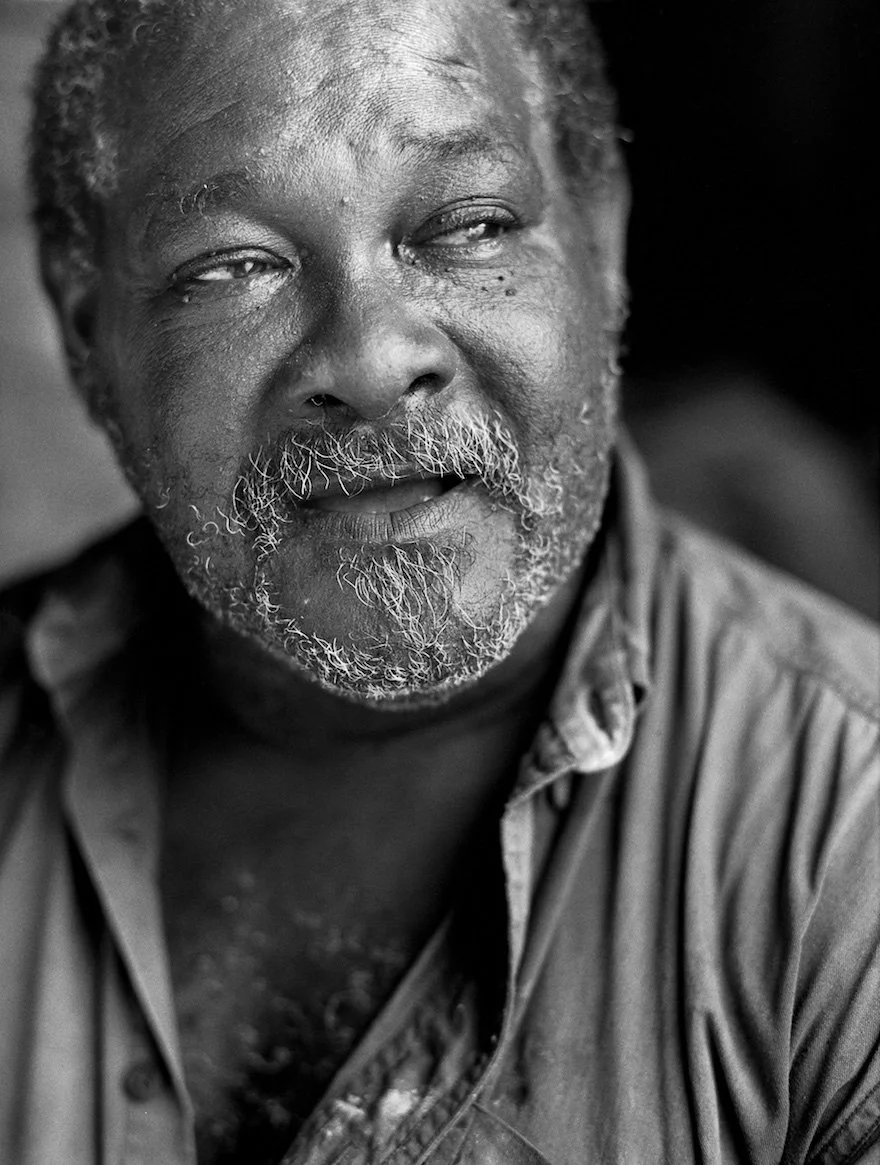
PURVIS
YOUNG
PURVIS YOUNG
Purvis Young
b. February 4, 1943 — d. April 20 , 2010
Miami, Florida
I been drawing all my life, but I taught myself to paint in the early seventies. I seen people protesting. I seen the war going on. Then I found out how these guys paint their feelings up North, paint on walls. That's when I start painting like that. I didn't have nothing going for myself. That's the onliest thing I could mostly do. I was just looking through art books, looking at guys painting their feelings. The first things I painted were heads with halos around them.
I started out about 1971 in Goodbread Alley. I wanted to express my own feeling. I wanted the peoples to see it. I put my paintings on a lot of fronts of abandoned buildings. They was fixing to tear them down and build an expressway. I knowed when I was making the art that one day it was going to go. Nothing's going to last forever.
The war was going on then, war in Vietnam. That's when all the demonstrations were going on, protests, protesters sitting in, marching. That's when I started the figure painting, people walking along, knocking each other down, like that. My feeling was the world might be better if I put up my protests. I figured the world might get better, it might not, but it was just something I had to be doing. I make like I'm a warrior, like God sending an angel to stop war. I think, like, I'm one of the figures in my art.
-
Goodbread Alley was just another alley. But it was a hell of an alley. Police wouldn't go into that place back then. They wasn't taking no chances.Shotgun houses used to be all around that place. Some people took good care of their houses. They were proud of their houses. But they all looked alike, you know, and the city had a problem with that, and tore the houses down. And they built apartments to take the place of the shotgun houses. They was just a bunch of old wooden houses, all looked alike. Things like that, it made me want to express my feelings. It was up to me to put up how I feel about stuff, like the protesters did.
Every day I came and find wood, you know, and put it up on a wall and paint it there in the alley, right off main street, 14th Street. Sometimes I dragged old crates down, you know, those moving crates. That was the biggest I would do. Sometime people would come swipe the paintings. I didn't care if my friends take them, I just put another one up.
After about two years people started driving in there to see the alley. A lot of tourists. Sometime they would buy a painting right off the wall, put it in their car and drive away. It was mostly white people interested. Some people would say stuff, say I looked like Gauguin, all different artists they say I looked like. A lot of black people seen them but they didn't say much to me about it. Some of them said I was mad, some cursed me out, some said I was sick. Some liked it, some of them admired me, some didn't. A friend of mine - he's passed away now - say to me, "I look at your paintings but I don't see nothing. But every time I turn around you're in the newspaper."
Some of the people that came to Goodbread Alley, they seemed to understand my paintings. Some of them I had to tell about it. There's a lot of stuff in my paintings people wanted to ask about back then. Like locks. I put locks in some of my paintings. A lot of people are locked up, struggling. The lock is playing a key part. It means mostly something's wrong.
I have painted a lot of boat people. I mostly see the boat people struggling. I see them on the news, where the boats turn over, or they get turned around, sent back. Sometimes I put sharks in my art, boats turning over with sharks around. Sometimes sharks keep peoples from getting to freedom. Sharks let you know it's dangerous coming across to Florida. Sharks are part of everybody's environment.
I always liked to draw and paint horses, wild horses. I just use horses mostly for freedom. I love to paint wild horses, freedom horses, wild horses running free.
Everyday I see in life pregnant women. I try to tell in my paintings that the pregnant woman is the birth of the earth. She represent some of the problems I see in the city. She's given birth to some of the characters around. But the way I feel about it is, they're all giving birth to angels.
I paint funerals and graveyards because I see a lot of my friends pass. I been to a lot of funerals. I paint angels coming down to bless the peoples; guys carrying caskets sometimes; angel sitting on top of the caskets. Death to the people. Good people become angels. I just paint good people. I don't know what happens to the bad ones. Sometimes when angels have come down to try to tell bad peoples what to do, they have hung the angels.
I like to show railroad tracks. When I was a boy you could tell colored town by the railroad tracks going across, separating the whites from blacks. Lots of times blacks was the ones built the tracks, like for Mr. Flagler on Florida's east coast. One way of knowing your environment is understanding the history. Blacks couldn't ride except on the back of the train, couldn't live but on one side of the tracks. But now the trains have come to mean freedom.
I see guys working, making a living with trucks. I love to paint trucks. The truck taken the place of the horse and buggy. The truck make works for the peoples. I create about the works.
When I paint I want to know if I'm telling the truth, if I'm listening to the truth or what.
As I get older, man, I'm getting to find out some things. I see how Russia played a key part in World War II. And black soldiers, too. I heard about the black army. I heard a black lady was talking about a cemetery for them in Miami and she say if she don't tell it, ain't nobody else going to tell it. Some things you just don't see in the history books.
I try to learn everything I can from the books, documentaries, and everthing I got to know so I can paint the truth. I walk around and look at the peoples, too, see if the peoples are happy. I looked at a lot of art books. Mainly I looked at the backgrounds. I'd learn something from what I see in the backgrounds. Like the landscape. Like the little figures. I see the same thing every day, little people I see every day on the street, they look like the little figures in my paintings. Everything in my paintings, just about, come from the neighborhood.
I get a lot of my ideas sometime just riding my bicycle around, just looking at reality, looking life right straight in its face. I walk, or either ride my bike, and look at peoples hanging around the buildings. I try to catch them in their environments and try to paint what I see. If they're not happy sometimes, I paint it like that.
Taken from interviews with Purvis Young by William Arnett and Larry Clemons in 1994 and 1995.







